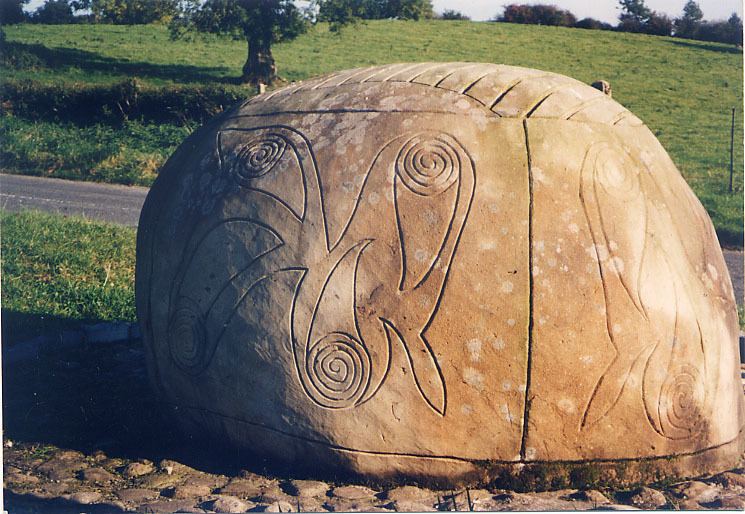Province Ulster | ||
 | ||
Killycluggin (from Irish: 'Coil a Chlogáin', meaning "the Wood of the Bell-Shaped Stone"), is a townland in the civil parish of Templeport, County Cavan, Ireland. It lies in the Roman Catholic parish part of Templeport and barony of Tullyhaw.
Contents
Map of Killycluggin, Co. Cavan, Ireland
History
The 1609 Baronial Map first depicts the townland, giving it the name "Killycluggin". It was subsequently shown on the 1665 Down Survey map and also began featuring in their prints.
Killycluggin is best known for the Killycluggin Stone, situated in a stone circle on Bannon's farm. Due to common belief that the stone's decorations represent Crom Cruach, a pre-Christian pagan god of Ireland, Killycluggin is known as the site where Crom Cruach became recognised. The stone became significant to the town on 23 June 1610 when The Plantation of Ulster along with King James VI and I decided to grant "Two polls of Kilclogen to Hugh Culme esquire, as part of the Manor of Calva." It was due to this motion that Clume surrendered his interest in Killycluggin to Walter Talbot of Ballyconnell. Talbot died on June 26, 1625 in Ballyconnell and his son, James Talbot, inherited the Killycluggin lands. He was ten years old at the time.
In 1635, James married Helen Calvert, the daughter of George Calvert, 1st Baron Baltimore. The couple had a son, George Talbot.
In the aftermath of the Irish Rebellion of 1641, James Talbot's estate in Ballyconnell was confiscated in the Cromwellian Act for the Settlement of Ireland 1652 because of Talbot's Catholic faith. He was later granted an estate in 1655 at Castle Rubey, County Roscommon as replacement. James died in 1687, upon which the lands at Killycluggin were divided between Dorby Don, John Reade, and Thomas Teddy.
James's son, George, went on to live a very fulfilling life, starting off with owing an estate in Cecil County, Maryland. George named this estate Ballyconnell in honor of his native town in Cavan. George was later appointed surveyor-general of Maryland in 1683.
After the Cromwellian settlement, Killycluggin went on to a man named John Blachford. John was born in 1598 in Ashmore, Dorset, England. He was the son of Richard and Frances Blachford. John became a merchant in Dorchester, Dorset, but fled to France in 1633 when facing a warrant from the Exchequer for not paying customs. Wedding bells sang yet again when John married a woman named Mary Renald, who was from Devon. Following their marriage, the couple bore four sons: John, Thomas, Ambrose, and William), as well as two daughters: Mary and Frances.
John died in Lissanover, County Cavan in 1661. Despite wishing to be buried back in Dorchester, he was buried in St. Orvins, Dublin. Following his death, John's will was published on 9 January 1665, leaving his son, John Blachford, as his sole heir. Following the publication, an inquisition was held in Cavan on 21 May 1667. This inquisition found that his widow, Mary Blachford as well as his son John were to be seized of, inter alia, the land of Killeclogine alias Killecragan.
Upon his father's death, John's son William went on to become a Major. He then dedicated a monument to his father before dying in Lissanover on 28 March 1727. The Blachford family gravestones in Templeport Church read as follows: This monument was erected by MAJOR WILLIAM / Blachford of Lisnover in 1721 to the memory of / his father, John Blachford, late of the same Esqr. but / from Dorchester in Dorsetshire, the place of his / nativity, who in his lifetime chose this for a burying / place, for himself and family, but died in Dublin / was buried in St. Orvins Church but his wife, MARY / RENALD of a Devonsheire family is buried here / as also three sons and two daughters, JOHN / AMBROSE AND THOMAS; MARY AND FRANCES / Here likewise lies buried two wives of MAJOR WILLIAM Blachford, son to the said JOHN Blachford viz / MARY MAGHEE of an ancient Family in Lincolnsheire. Cornet Chidley Blachford, son to MAJOR WILLIAM Blachford, leys buried here who dyed August ye 29th, 1722. This about MAJOR WILLIAM Blachford. / That erected this monument, died the 28th of March 1727, aged 69years.[7]
Books
The Tithe Applotment Books for 1827 list four tithe payers in the townland.
Griffith's Valuation of 1857 lists sixteen landholders in the townland.
In the 1901 census of Ireland, there were ten families listed in the townland, and in the 1911 census of Ireland, there were only nine families listed in the townland.
Antiquities
There are several chief structures of historical interest in the town and the land.
